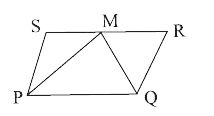
In the figure above, PQRS is a parallelogram and G is the centroid of the triangle PQR . A is the point of intersection of the diagonals PR and SQ. If AG=3 cm, then find the length of SQ.
The correct Answer is:18 cm
Step by step video, text & image solution for In the figure above, PQRS is a parallelogram and G is the centroid of the triangle PQR . A is the point of intersection of the diagonals PR and SQ. If AG=3 cm, then find the length of SQ. by Maths experts to help you in doubts & scoring excellent marks in Class 7 exams.
Updated on:21/07/2023Similar Questions
Knowledge Check
In the given figure, PQRS is parallelogram, then find the area of ΔPQX.
 A80 cm2B40 cm2C120 cm2D60 cm2
A80 cm2B40 cm2C120 cm2D60 cm2The centroid of an equilateral triangle ΔPQR is L. If PQ = 18 cm, then the length of PL is :
A4√3cmB6√3cmC3√3cmD5√3cmPQRS is a parallelogram in which PR is perpendicular to QS. If PR=8cm and QS=6 cm, then find PS
A5 cmB4 cmC7 cmD6 cm
PQR is an equilateral triangle. O is the point of intersection of altitudes PL,QM and RN. If OP=8cm, then what is the perimeter of the triangle PQR ?
View SolutionPQRS is a rhombus whose diagonals are PR=6 cm and QS=8 cm . If O is the point of intersection of diagonals and ∠PQO=θ then find the value of sinθ,tanθ and secθ
View SolutionPQRS is a square. PR and SQ intersect at O. Then ∠POQ is a
View SolutionPQRS is a Parallelogram and PQM is a triangle. If area of PQM=18cm2. Find the area of PQRS.

View SolutionIn a rhombus PQRS , PR and QR are the diagonals of the rhombus. If PQ=10cm, then find the value of PR2+QS2.
View Solution


